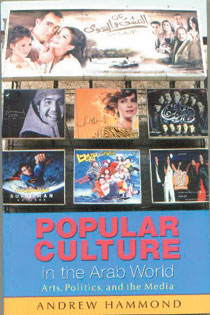ANYONE interested in the Middle East should read “Popular Culture in the Arab World: Art, Politics, and the Media.” The well-researched book “focuses on the greater Arab-Islamic tradition and the vibrant contemporary culture that refers to itself as Arab” writes the author in the preface.
The main idea of the book is that popular culture and not politics unites Arab countries. This powerful notion is the driving force behind this fascinating book.
Before Andrew Hammond tackles engaging themes such as Arab pop music, the power of the Arab satellite channels and the increasing consumer culture, he devotes a whole chapter to the Arabic language which has been a unifying factor in the region. With the help of satellite channels promoting singers and TV presenters from all over the Arab world, colloquial dialects, whether from the Gulf or the Maghreb, are no longer seen as a dividing factor but rather as a means to facilitate mutual understanding between different countries.
The author also highlights the positive role played by the written media “in simplifying classical Arabic for modern usage.” Novelists and poets are following suit as they aspire to reach a greater number of readers by using colloquial rather than classical Arabic. As a result the Arabic language is rediscovering its plural roots from centuries ago when it absorbed a number of foreign words: “Only today are linguists and sociologists coming to grips with the idea of Arabic as a dynamic and changing language” explains Hammond.
The present vitality of the Arabic language is unfortunately shadowed by Arabic literature’s lack of recognition. Literature, in the Arab world, is not a popular topic; it is rarely discussed on television and up to the present, there is no best seller list available. Even Egypt’s main English newspaper, Al Ahram Weekly, has stopped publishing a monthly literary supplement. However, the literary scene in the Arab world is vibrant and alive with a whole new generation of young writers. While a breed of savvy and innovative writers is coming up in Egypt, other regional literatures, unknown previously, such as Gulf literature, Palestinian and North African literature, are gaining momentum. Unfortunately, Arab literature lacks Arab readers: “A bestseller in Egypt might sell as few as 10,000 copies, even though the country’s population is over 70 million,” explains Hammond. Consequently, many Arab writers are genuinely grateful when their works are translated into English. In this respect, the American University in Cairo Press is spearheading the efforts to familiarize the world with the works of an unprecedented number of Arab essayists, historians, sociologists, and novelists in particular.
Religious culture, on the contrary, has gained in popularity since the 1970’s especially in Egypt. Books and religious cassettes are competing now with an increasing number of television programs and the Internet. New faces are causing a stir, especially the Egyptian Amr Khaled dubbed the “society sheikh.” Hammond says, “Though he lacks formal qualifications and doesn’t sport a beard or wear clerical robes, Khaled has become well-known through regular appearances on numerous Arab satellite channels (he appears weekly before a rapt audience on Iqra) and Internet sites www.forislam.com. Khaled is interesting too because of the overt absence of a political agenda in his preaching.”
In the last few decades, religious conservatism has swept across Arab countries but this strengthening of Islamic faith is also happening at a time when Muslims feel threatened and ostracized, particularly by Western powers. In this respect, Hammond rightly observes: “It has become received wisdom in the Arab world that the United States wants to ‘secularize’ Islam and reduce its social and political power in Egypt and Saudi Arabia in particular.”
Three of the most entertaining chapters focus on Arab consumer culture, Arab pop and the satellite revolution. It is obvious that the author has lived in the Arab world. And he has made good use of his first hand experience. Almost nothing escapes his attention, from the growing consumerism which is even affecting the holy month of Ramadan to the increasing popularity of the ‘shisha’. In Beirut, you can order a ‘shisha’ (water-pipe) on the phone! The author also highlights the successful creation of an Arab pop music which, for more than two decades, has been successfully competing with Western pop music, a success boosted by the satellite channels. He even mentions the famous interview when Shaaban Abdel-Rahim, the singer people love to hate, told the TV host that his outrageous flowery shirt was made from the same material used to cover his mother’s sofa. Andrew Hammond’s thorough research laced with pertinent remarks and genial observation add a touch of brilliance and make this a fascinating read.


